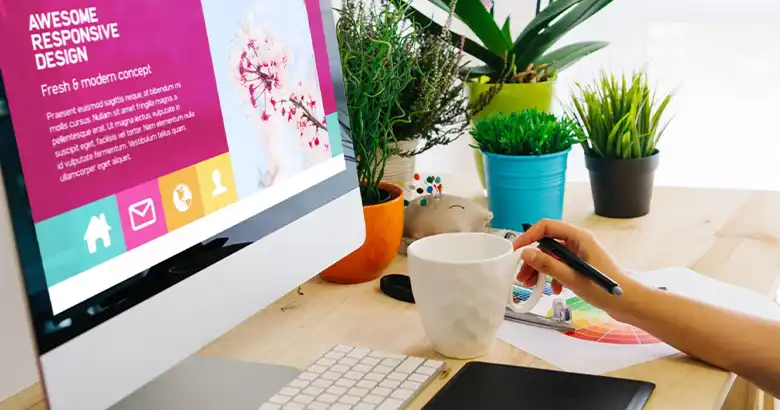Read this article for a low-down on UX Designer portfolios and on-point advice on how to create a standout one, along with some world-class inspiration to get you on your way.
Are you ready to showcase your UX design talents to the world? Or are you looking for inspiration on how best to tell your unique UX story?
Perhaps you’re applying for your first UX design position, hoping for a promotion at work, or looking to land some new clients as a freelancer. If any of these sound like you, then your portfolio will be a determining factor in your success. However, knowing exactly what to include in your portfolio, what to leave out, and how best to display your work can be tricky.
In this article, we’re here to help. We’re going to be getting you up to speed on what employers will be looking for in your portfolio, as well as providing detailed breakdowns of seven of our favourite UX designer portfolios so you can get inspired by some of the great UX design examples that are already out in the world.
Here’s a clickable list of everything we’ll be covering so that you can jump to the section or portfolio that interests you the most.
- 1) What is a UX designer portfolio?
- 2) Why do you need one?
- 3) What to include in your UX designer portfolio
- 4) 7 of the best UX designer portfolios
1. What is a UX designer portfolio?

A great UX designer portfolio will seek to provide insights into your working style, process, skillset , and approach to addressing challenges, in addition to how you work with users, and how well you collaborate with others. Although the term “portfolio” can bring to mind a visual representation of your creativity or visual design talent via projects you’ve worked on or companies you’ve been employed by, as a UX designer your design portfolio needs to be a portal into a variety of other components which demonstrate to a potential employer or client your unique approach, values, and work ethic.
In addition to showcasing your favourite projects or client work, you should aim to answer the following questions in your portfolio:
- How do you approach usability?
- How user-centric is your approach?
- What methods do you use to solve problems?
- How do you like to collaborate with others?
- Which UX design principles are particularly important to your practice?
2. Why do you need a UX designer portfolio?
A UX designer portfolio is a crucial element of the job application process when you start looking for a position in the field. Many employers will be more interested in seeing your portfolio than knowing the school you went to, or the degree level you’ve attained. During interviews you’ll likely be asked to walk your interviewer through your favourite projects, elaborate on how you overcame challenges, and discuss any previous work experience at other companies. Your portfolio is a useful prop during these conversations as it provides concrete evidence of your work and a visual guide to your style and work processes. This is one of the key reasons why AND learners enrolled in any of our UX UI Design courses work on projects regularly throughout the course.

3. What to include in your UX designer portfolio
We’re going to be providing you with a comprehensive list of some of the best UX designer portfolios out there so you’ll get an idea of the key elements you need to include and get exposure to the wide range of approaches out there.
Before we launch into our favourite UX design examples though, here’s a list of the essentials your potential employer will certainly expect to see in your portfolio:
- Introductory page/homepage, including career highlights, and major clients or projects
- A menu of contents
- A handful of examples of your favourite projects and case studies from previous clients or employers
- A contact page including social media handles and an email address
- An About Me page detailing your working style and process, your resume and your education
4. 7 of the best UX designer portfolios
We’ve collected together some of our favourite UX designer portfolios. From a senior product designer at Squarespace, to a UX and interaction designer at Google and YouTube, get inspired by these highly accomplished and award-winning UX professionals and their unique, compelling, and user-centric approaches to their UX designer portfolios.
UX designer portfolio no. 1: Austin Knight

Austin Knight is a design lead at Square, an eCommerce and payment solution site, where he heads up a team of designers.
What makes his portfolio great?
Austin’s site is a powerful advertisement for his passion for UX design. He grabs the reader's attention with an authentic introduction to his work that expresses his genuine love of design. He mentions his previous roles at major employers, Google and HubSpot, and invites the reader to join him on his learning journey which highlights the multiple resources his site has to offer visitors in the form of essays, speaking engagements, and a podcast.
Key elements of Austin’s portfolio
- He has a bullet list of his major achievements and important information, from mentoring at Columbia and Stanford, through to his location and personal preferences, enabling visitors to see his milestones at a glance
- Blog articles and podcasts offer significant value to the user while also demonstrating his passion for the field
- The selection of use cases and projects on the homepage are both visually appealing and easily navigable
- A neat timeline of his employers appears at the top of the page, with a short summary of each one appearing when the company logo is clicked for quick browsing
- All the need-to-know info is on one scrollable page, enabling easy access to potential clients or employers
- His portfolio ends with the option to join his newsletter or contact him personally; again demonstrating his personal commitment to the field
- The tone of Austin’s portfolio is professional and informative, yet extremely accessible and friendly
Biggest takeaway
While Austin’s site is packed with useful information and resources, the biggest takeaway from his portfolio is the passion he has for his work and his desire to share his learnings in the field with others. In addition to his paid work, his profile showcases the significant amount of UX-related work he undertakes voluntarily, such as mentoring UX design students, writing articles, giving keynote speeches, and assisting non-profit organisations. If you’re looking for ways to boost your portfolio, you can follow Austin’s example and showcase your passion for the field with examples of unpaid UX design work such as writing a blog, organizing a meetup, or mentoring someone more junior to you.
UX designer portfolio no. 2: Kyson Dana
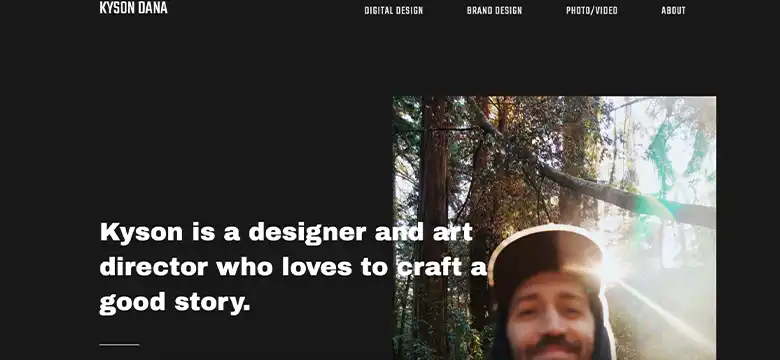
Kyson Dana is an associate creative director at Rivian, a manufacturer of electric adventure vehicles. He previously worked as lead UX designer at Boosted, a leading producer of electric scooters and skateboards.
What makes his portfolio great?
Kyson’s portfolio lets his work do the talking, with his use cases placed front and centre of his portfolio page. This is combined with clear labelling of his niches, Digital Design, Brand Design, and Photography/Video, allowing potential clients to read more about his work in these areas. The success of Kyson’s portfolio lies in its simplicity; it doesn't overwhelm the user and navigation between pages is both intuitive and seamless.
Key elements of Kyson’s portfolio
- Kyson’s use cases are in-depth stories of his work on each project. Each use case provides readers insights into his work process, style, ethics, collaboration techniques, approach to responsibility, and his ability to reflect on his learnings. This is all crucial information for potential employers or clients and includes stunning visuals and excellent storytelling
- Although the homepage is relatively text-light, readers can hop over to Kyson’s About Me page for his work history in UX, where he finds his inspiration, and what drives him professionally
- Kyson offers a downloadable version of his resume at the bottom of his About Me page
- Every page of the website provides links to his social media handles
- Kyson adds a personal touch by including a couple of photographs of himself and mentioning a few of his key interests outside of design–helpful when a potential employer is considering cultural fit
- He charts his learnings in a short summary at the end of each project
Biggest takeaway
The intuitive navigation of Kyson’s portfolio, combined with the impressive visual catalogue of his work, make Kyson’s portfolio a great example of what can be achieved with the user-focused design. His commitment to detailed storytelling is also a huge asset to his portfolio.
UX designer portfolio no. 3 Liz Wells

Liz Wells is an award-winning and critically acclaimed senior product designer at Squarespace, a leading website-building and hosting company. Previously, Liz worked as a senior product designer at SuperHi and as a senior user experience designer at Stink Studios designing experiences and products. Working at the intersection of art and design, Liz’s portfolio website demonstrates an inspirational and unique approach to design that keeps the content easy to navigate while still showcasing the talents and personality of the designer.
What makes her portfolio great?
Liz’s portfolio is extremely visually engaging. When the user hovers the mouse over a project title on the homepage, an image from the project appears and moves with the mouse, leaving a residual trail of colour and shapes behind it. This unique approach to introducing her projects is intriguing to the user and prompts further action, namely clicking on the project to find out more. Once the user clicks on a project, the more eccentric design is left behind and each stage of the design process is clearly laid out and described in detail. This approach allows Liz to shine a light on her product development talents, her process and work ethic, and how she works with others in addition to delighting users with her visual design abilities.
Key elements of Liz’s portfolio
- The design of her site is a true reflection of her unique approach as an artist while still maintaining high levels of usability and functionality for visitors
- Liz demonstrates her own creative projects alongside professional engagements to showcase her passion for design, her range, and her versatility
- Her “Info” page details her clients, speaking engagements, education, teaching work, press coverage, and awards
- Links to both “Info” and “Index” float at the top of every page while the user is scrolling, ensuring they are never lost within the site
- Liz uses video, images, and storytelling to describe each use case on her site, keeping the user engaged throughout the timeline of each project
- Liz has her social media handles and contact details on every page of the site
Biggest takeaway
What we can take away from Liz’s portfolio is the importance of showcasing some individuality in your design work. As we’ve seen, this captures the user’s attention, informs memorable designs, and demonstrates a unique and creative approach. What Liz does really well is combine a more unusual aesthetic with great usability, functionality, and navigation, so at no point is an intuitive and usable experience sacrificed for the sake of creativity. This leaves users coming away from her portfolio both delighted and well-informed.
UX designer portfolio no. 4: Karolis Kosas
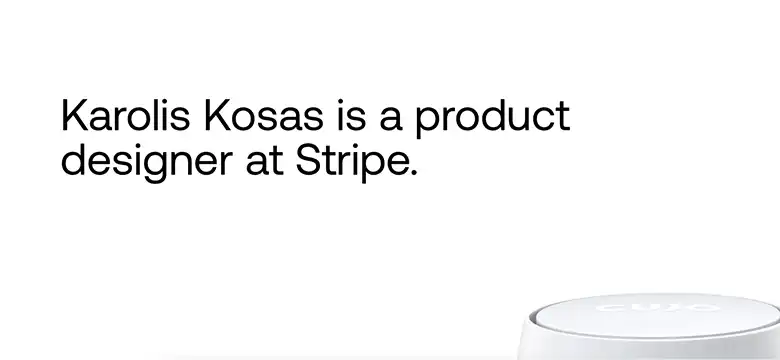
Karolis Kosas is a product designer at Stripe, an online payment processing solutions company. He is a co-founder of ANCHOVY and was previously art director at Rapt Studio.
What makes his portfolio great?
Karolis has created the perfect minimalist UX designer portfolio. Karolis keeps simplicity at the core of his portfolio by including all key information and images on the homepage, creating an impactful and immediate impression. When additional links are needed, they are used sparingly to provide more information on specific projects.
Key elements of Karolis’ portfolio
- The clean and simple design presents key information to users in an easy-to-digest format
- Karolis’ homepage is centred around his projects. Using an eye-catching image and short intro text for each use case, he gives the user a taste of what he has worked on without overwhelming the reader with too much information
- Use case pages are kept extremely simple too: Karolis outlines only his role in the project and the results of the project before using just images and video to tell the rest of the story
- Navigation is, as expected, very simple. At the bottom of every use case page, the user is given labels which state ‘Up’ and ‘Back’ to help them find their way
- Rather than an additional page for work experience and education, Karolis includes his published writings and speeches in a simple list at the bottom of the page, along with an email address for contacting him
Biggest takeaway
Besides the simplicity and attractiveness of the overall design, how Karolis presents each use case is a great example of what to include and what to leave out when demonstrating your work to potential employers. Rather than providing lengthy details on how each project came together, Karolis instead focuses on the results of the project and his role in bringing them about. In a job interview scenario , an interviewer can ask for more detail on work processes and collaboration if necessary.
UX designer portfolio no. 5: Priyanka Gupta
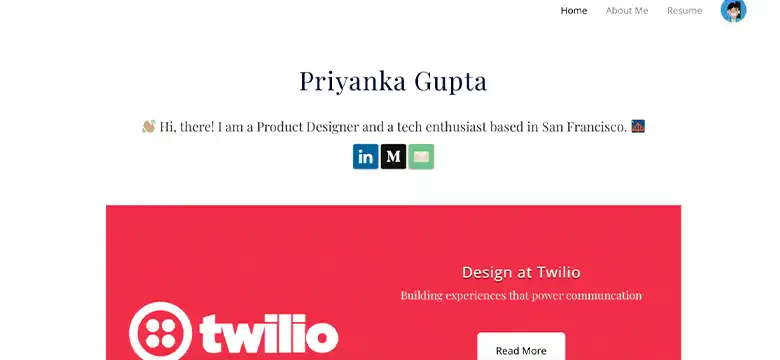
Priyanka Gupta is a product designer and self-confessed tech enthusiast currently working as a staff product designer at Twilio, a company which provides programmable communication tools, in San Francisco. Previously, Priyanka worked as a product designer at Grand Rounds, and as a UX design specialist at SAP Labs.
What makes her portfolio great?
The standout feature of Priyanka’s portfolio is the selection of unsolicited redesigns she has completed for companies she has not actually worked for. That’s right, she’s taken on numerous bad UX designs and transformed them into fantastic ones, just because she’s so passionate about what she does. Priyanka certainly doesn’t need to demonstrate her skills this way: she has more than enough experience in the field to fill her portfolio with her own use cases and projects. However, she’s chosen to take on these redesigns because this is a great way to demonstrate her commitment to the field, her passion, her skills, and her approach, which is what employers or potential clients will want to see. If you’re new to UX design, this is a great way to showcase your skills before you’ve landed your first paid job.
Key elements of Priyanka’s portfolio
- Unlike some of the other portfolio sites we’ve showcased here, Priyanka chooses to include her full resume as a page of her website. Although it’s not strictly necessary to go into detail that Priyanka does here, her inclusion of the digital tools she’s fluent in, social media handles, skills, press coverage of her work, and her education are all certainly worth mentioning
- The text on her About Me page is concise but personal and relevant. The inclusion of a photograph also gives the reader an idea of the person behind the work
- The documentation of both her real-life work projects and her unsolicited redesigns go into incredible detail. Priyanka explains the entire process of each design or redesign, including user research, testing, affinity maps, and much more. She complements these narratives with extensive images and photographs to demonstrate each phase of the process
- She details her learnings from the project on some of the longer use cases. This is a great way to show employers that she can reflect on her process and is mindful of what she might do differently next time
Biggest takeaway
Priyanka’s portfolio teaches us that through unsolicited designs we can showcase our skills, knowledge, passion, and commitment to UX design without having a huge amount of paid project experience behind us. From this starting point, a less-experienced UX designer is much more likely to land a junior position as employers can visualize how they’d work in a real-world scenario and can see their enthusiasm for learning through their unpaid work experience.
UX designer portfolio no. 6: Lola Jiang
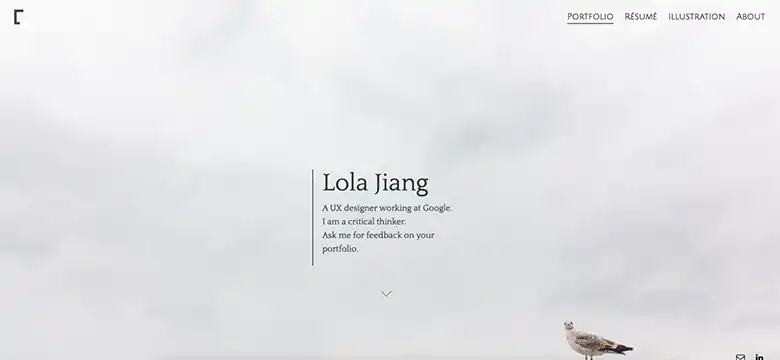
Lola Jiang is a California-based UX designer at Google. Previously, she worked as an interaction designer at YouTube. She applies a critical thinking approach to her UX design work and seeks user validation of her ideas at all times.
What makes her portfolio great?
In addition to the rather beautiful visual design of her portfolio, Lola’s UX design profile is unique in that it clearly demonstrates her commitment to proving the measurable impact of her work when placed in the context of the business’s goals and needs.
Key elements of Lola’s portfolio
- Use cases are elegantly documented with images and photographs to provide context for the reader. She includes an intro to set out the problem she is trying to solve, before and afters of the redesign, user challenges that pop up along the way, what’s coming next, and her final thoughts covering what she has learned from the project.
- She consistently seeks to demonstrate the measurable impact of her work with each project, using facts and statistics to back up her claims and validate her designs: “The new design reduced task times by 68% and improved users’ subjective satisfaction by 139%.”
- She ends each page of her portfolio website with a CTA to “Book with Lola”, promoting her work as a mentor and providing feedback on UX portfolios
- Her About Me includes a list of her favourite UX design books, a quirky and unique feature that demonstrates her passion for the field, her desire to keep learning, and her commitment to staying up to date on UX trends
Biggest takeaway
What Lola does really well is to provide employers with a case for investing in UX design. She does this through the use of metrics in her use cases, which prove how good UX boosts both customer satisfaction and revenue. By approaching her use cases in this way, she is demonstrating her value to businesses using terms that are important to them and their shareholders.
UX designer portfolio no. 7: Zara Drei
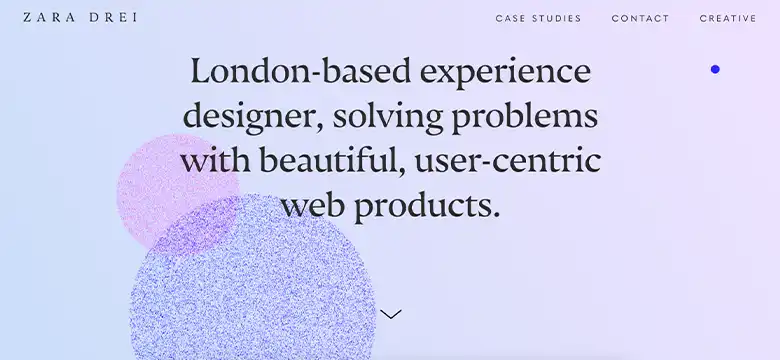
Zara Drei is a design lead in London working in UX, UI, print, motion, and video, among others, creating digital products and experiences for luxury, fashion, and beauty brands.
What makes her portfolio great?
Zara’s portfolio isn’t just visually stunning, it’s interactive, diverse, intuitive, and responsive, demonstrating her skills in these areas of design. It’s also a great advert for her work creating digital experiences in the beauty, fashion, and luxury space. Her portfolio demonstrates beauty and functionality working in harmony to provide the desired experience for the user as well as showcasing Zara’s UX and UI talents.
- Her highly detailed use cases demonstrate her work processes, style, and approach. Each is broken down into relevant sections, including the challenge, business needs, user needs, component redesign, effective wireframing, design system, responsive animated assets, content management, validation, and outcome
- Zara details the tools she has used, her collaborators, and her role in the project
- While the use cases make up the core of her portfolio, she also has a gallery for users to click through to get an overview of her clients, her key industries, and her most successful campaigns at a glance
- Her portfolio is delightful to interact with and beautiful to look at, reflecting her experience in industries highly concerned with aesthetics
Biggest takeaway
Zara’s portfolio is clearly designed with her target client base in mind. As a designer in the beauty, fashion, and luxury space, her profile reflects her aesthetic sensibilities, draws in the eye, delights the user, and showcases her talent for and experience in designing for these specific industries.
Next Steps
In this article, we’ve taken a look at the essential elements you need to include in your UX design portfolio and provided you with key UX design examples from some of our favourite designers working today to inspire and encourage you on your own UX journey.
If you’re at the start or early stages of your UX design journey, one of the best ways to build your portfolio is to undergo a training course. A high-quality course will not only provide structured learning but also opportunities for hands-on project work, and will typically culminate in an industry-ready portfolio built with extensive mentor feedback and inputs.
Next Steps
Want to learn more about UI design? We’ve got more insightful articles like this one over on the AND Academy Design Blog. You can also check out this project by AND Learner, Aromal Jose Baby to get inspiration for your next project!
In case you think you need further assistance, here are some of our resources you can consider:
- Watch this session by Shiva Viswanathan, Design Head of Ogilvy Pennywise, and Naman Singh, Product Experience Designer at RED.
- Talk to a course advisor to discuss how you can transform your career with one of our courses.
- Pursue our UI UX Design courses - all courses are taught through live, interactive classes by industry experts, and some even offer a Job Guarantee.
- Take advantage of our scholarship and funding options to overcome any financial hurdle on the path of your career transformation.
Note: All information and/or data from external sources is believed to be accurate as of the date of publication.

